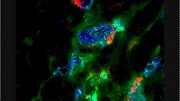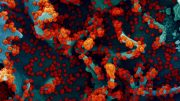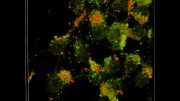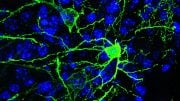
Parkinson’s disease is a brain disorder that causes unintentional or uncontrolled movements including trembling, stiffness, and issues with balance and coordination.
Scientists take the next step in understanding the role it plays in the disease.
There are currently no disease modifying therapies for Parkinson’s disease available that can alter the course of the disease. Researchers from the University of Colorado Anschutz Medical Campus are leading a group of experts from across the world who are attempting to change that.
Recently, they published a new study in the journal Brain that brings scientists one step closer to comprehending a crucial protein called α-synuclein (αSyn), which they discovered connects inflammation and Parkinson’s disease.
The protein αSyn is mostly expressed in neurons and has been linked to neurodegenerative diseases such as Parkinson’s disease and Lewy body dementia. This new study identifies a new mechanism linking interferon activation and αSyn function in neurons as a possible trigger for Parkinson’s disease development.
“It’s critical to understand further the triggers that contribute to the development of Parkinson’s disease and how inflammation may interact with proteins found in the disease. With this information, we could potentially provide new approaches for treatments by altering or interfering with these inflammatory pathways that may act as a trigger for the disease,” said David Beckham, MD, associate professor in the department of infectious disease at the University of Colorado School of Medicine – located on the CU Anschutz Medical Campus.
To investigate the mechanism of αSyn-induced immune responses to viral infections in the brain, the researchers challenged αSyn knock-out (KO) mice and human αSyn KO dopaminergic neurons with RNA virus infection. They discovered that αSyn is required for neuronal expression of interferon-stimulated genes (ISGs). They then found that following any stimulus that triggers interferon signals, a type of immune response, αSyn interacts with signaling proteins in neurons to trigger the expression of ISGs.
This study establishes the first clear link between inflammation and αSyn, a protein connected to the development of Parkinson’s disease.
The scientists state that these findings demonstrate that αSyn responds to infection and inflammatory pathways and that this connection may have a crucial role in the development of Parkinson’s disease. The next critical step is to see whether interactions between interferon and αSyn result in the formation of toxic forms of misfolded αSyn known as fibrils, which have been found in Parkinson’s disease.
The researchers suggest future studies are needed to look into the interactions between type 1 interferon signals in neurons and misfolded αSyn to determine if drugs that inhibit these interactions can prevent the formation of misfolded αSyn. This would result in a potentially disease-modifying therapeutic approach that is needed for patients.
Reference: “Alpha-synuclein supports type 1 interferon signalling in neurons and brain tissue” by Brendan Monogue, Yixi Chen, Hadrian Sparks, Ranya Behbehani, Andrew Chai, Alexander J Rajic, Aaron Massey, B K Kleinschmidt-Demasters, Matthieu Vermeren, Tilo Kunath and J David Beckham, 21 July 2022, Brain.
DOI: 10.1093/brain/awac192









Be the first to comment on "Parkinson’s Breakthrough: A Recent Discovery Could Lead to New Treatments"